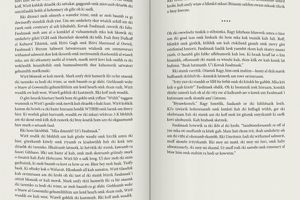Referencing a specific location within a larger work, such as a book, is crucial for academic integrity and allows readers to locate the exact information being referenced. This practice involves providing the author’s name, the book title, publication year, and the specific page number or range where the cited information appears. For instance, a reference might look like this in the text: (Smith, 2020, p. 45), indicating the cited information can be found on page 45 of Smith’s book published in 2020.
Accurate source attribution strengthens arguments by providing verifiable evidence and giving credit to original authors. Consistent and correct citation practices enhance the credibility of research and demonstrate a respect for intellectual property. Historically, the evolution of scholarly communication has led to formalized citation styles and conventions, aimed at ensuring transparency and replicability in research findings. Adhering to these standards facilitates a clear lineage of ideas and promotes scholarly discourse.
The subsequent sections will detail common citation styles and their specific guidelines for referencing pages within books, provide practical examples for various scenarios, and address common challenges encountered during the citation process, offering solutions and best practices to ensure accuracy and completeness.
Tips for Citing a Page in a Book
Accuracy and consistency are paramount when integrating references to pages within books. The following guidelines offer practical advice for navigating the nuances of source attribution.
Tip 1: Understand the Specific Citation Style: Familiarize yourself with the guidelines of the required citation style (e.g., MLA, APA, Chicago). Each style dictates specific formatting requirements for page numbers, punctuation, and the placement of the citation within the text.
Tip 2: Verify Page Numbers: Ensure the accuracy of the page number(s) being cited. Double-check against the original source to prevent errors. Inaccurate page references undermine the integrity of the citation.
Tip 3: Use Page Ranges When Necessary: When referring to a continuous passage spanning multiple pages, indicate the entire range (e.g., pp. 50-55). Be precise in defining the start and end points of the cited material.
Tip 4: Differentiate Between Print and Digital Editions: If using an e-book or digital version, page numbers might differ from the print edition. If the digital edition lacks page numbers, use alternative locators such as chapter numbers or section headings (if permitted by the citation style).
Tip 5: Pay Attention to Punctuation: Citation styles often have specific punctuation requirements for citing pages. For example, the abbreviation “p.” or “pp.” might be required before the page number(s), and a comma might separate the year and page number. Adhere to the prescribed punctuation to maintain consistency.
Tip 6: Include In-Text and Bibliographic Citations: A complete citation includes an in-text citation (also known as a parenthetical citation or footnote) and a corresponding entry in the bibliography or works cited list. The in-text citation provides a brief reference within the text, while the bibliographic entry provides full details about the source.
Consistent and accurate citation of pages within books ensures transparency, strengthens arguments, and demonstrates academic rigor. Adherence to these tips will contribute to the overall credibility of the research.
The subsequent section addresses the formatting of in-text and bibliographic citations across different citation styles, providing further guidance on accurately referencing pages in books.
1. Specific Page Number
The specific page number is a fundamental element in source attribution. Its inclusion is non-negotiable when pinpointing particular information within a book. It serves as a direct pointer, enabling readers to quickly locate the cited material in the original source. Without this level of detail, the citation lacks precision and diminishes its value in supporting scholarly arguments.
- Verifiability and Credibility
The inclusion of a specific page number or range allows for immediate verification of the cited information. This directly impacts the credibility of the writer and the integrity of the research. For example, if a statement is attributed to “Smith, 2010,” without a page reference, the reader must search the entire work to find the supporting evidence. With “Smith, 2010, p. 62,” the reader can immediately assess the accuracy and context of the quotation or paraphrase. This meticulousness underscores the rigor of the research process.
- Distinction Between Editions
Page numbers are critical for distinguishing between different editions of the same book. Pagination can vary significantly across editions, even when the content remains similar. Citing only the author and year might lead a reader to the wrong passage if they are consulting a different edition. The specific page number ensures that the reference is unambiguous and points to the correct location, regardless of the edition being used. Consider a scenario where a book is revised and expanded. A citation to “Jones, 1995” would be insufficient if a reader is consulting the 2005 revised edition; including the specific page in the original 1995 edition offers precision.
- Legal and Ethical Considerations
Clear citation of specific locations is also relevant to legal and ethical guidelines related to plagiarism. Providing a specific page number minimizes the risk of misrepresenting the original author’s work or inadvertently claiming their ideas as one’s own. Failure to do so, even if unintentional, can have serious consequences in academic and professional contexts. Accurately noting where a specific idea or quotation comes from is necessary to uphold proper citation of all content.
- Efficiency in Research and Academic Discourse
Precise page references significantly improve the efficiency of research and academic discourse. They allow researchers to quickly locate relevant material, compare interpretations, and build upon existing knowledge. Vague references hinder this process and can lead to wasted time and effort. The ability to promptly access and verify information streamlines the process of building knowledge and promoting scholarly communication. For example, a researcher studying the history of a particular concept can quickly compare different interpretations across multiple sources by referencing the cited page number for each source.
In conclusion, the specific page number is not merely a detail but a core component of ethical and effective research. It guarantees verifiability, distinguishes between editions, mitigates legal and ethical risks, and promotes efficiency in academic discourse. Each of these facets reinforces the inherent connection between providing accurate page references and the process of source attribution.
2. Citation Style Compliance
Citation style compliance is inextricably linked to the practice of referencing a page within a book, acting as the governing framework for accurately attributing specific information. The effectiveness of referencing a page hinges directly upon adherence to a designated citation style’s guidelines. Failure to conform to these standards renders the citation incomplete and potentially misleading, thereby undermining the credibility of the work. The different styles (e.g., MLA, APA, Chicago) each have unique rules regarding the presentation of author names, publication years, titles, and, critically, page numbers. For instance, while one style might mandate the abbreviation “p.” before a page number, another might omit it. These seemingly minor differences cumulatively affect the clarity and professional appearance of the research.
The implications of neglecting citation style compliance extend beyond mere formatting errors. Inconsistent or incorrect citations can hinder the reader’s ability to locate the original source, thus impeding the verification of information and potentially leading to accusations of plagiarism. Consider the case of a researcher using the APA style but omitting the “p.” before the page number in in-text citations. While the citation might still convey the general source, its lack of adherence to the style guide suggests a lack of precision and rigor, casting doubt on the overall reliability of the research. Correct citation style compliance ensures consistency and aids in cross-referencing. A reader familiar with the particular citation style can quickly locate the correct source location. Furthermore, journal publications and academic institutions have formatting requirements to ensure consistency.
In summation, citation style compliance constitutes a fundamental component of effectively referencing a page within a book. It serves as the essential bridge between the cited information and its source, providing the necessary framework for accurate attribution and facilitating the verification of research findings. Adhering to the stipulated guidelines of the chosen citation style is paramount for maintaining academic integrity and promoting transparency in scholarly communication. Challenges with citation styles often involve correctly interpreting the manual and adhering to small differences between styles. However, the investment in understanding these guidelines is crucial for ensuring the credibility and effectiveness of the research.
3. In-Text Integration
In-text integration represents a pivotal step in source attribution, dictating how references to specific pages within a book are incorporated into the surrounding prose. The manner in which these references are presented directly impacts readability, clarity, and the overall flow of the argument. Effective in-text integration seamlessly weaves source material into the narrative, providing appropriate credit while minimizing disruption to the reader’s understanding.
- Clarity and Context
The primary goal of in-text integration is to provide clarity and context for the cited material. References should not appear as abrupt interruptions but rather as natural extensions of the author’s own thoughts. For example, a simple statement like “According to Smith (2010, p. 42),…” introduces the source smoothly, preparing the reader for the cited information. Conversely, a poorly integrated citation, such as “…(Smith, 2010, p. 42),” without any preceding context, can disrupt the flow and leave the reader wondering about the relevance of the source.
- Signal Phrases and Attributive Tags
Signal phrases and attributive tags play a crucial role in guiding the reader through the source material. These phrases, such as “as argued by,” “as noted in,” or “according to,” explicitly indicate the source of the information and its relationship to the author’s argument. Effective use of these phrases enhances the credibility of the writing by clearly delineating between the author’s own ideas and those derived from external sources. Consider the difference between “The study revealed a correlation between X and Y (Jones, 2005, p. 15)” and “Jones (2005, p. 15) found a correlation between X and Y.” The latter integrates the source more seamlessly into the sentence, providing a clearer indication of the origin of the finding.
- Placement and Punctuation
Accurate placement and punctuation are essential for maintaining grammatical correctness and avoiding ambiguity. In-text citations typically appear at the end of the sentence or clause containing the cited material, enclosed in parentheses. The punctuation surrounding the citation must be carefully considered to ensure that the sentence remains grammatically sound. For instance, a citation at the end of a sentence should be placed before the final period (e.g., “This is a concluding statement (Smith, 2010, p. 42).”). Incorrect placement or punctuation can create confusion and undermine the credibility of the citation.
- Avoiding Over-Citation
While it is crucial to provide adequate attribution, excessive citation can be equally detrimental to the readability of the text. Over-citation can disrupt the flow and make the writing appear cluttered and cumbersome. Authors should strive to strike a balance between providing sufficient evidence and maintaining a clear and concise narrative. Rather than citing every single sentence, authors should focus on citing the specific passages that directly support their claims or contribute to the overall argument. In cases where multiple consecutive sentences draw from the same source, a single citation at the end of the passage may suffice.
In conclusion, effective in-text integration is a crucial component of referencing specific pages within a book. By providing clarity, context, and seamless integration of source material, authors can enhance the readability, credibility, and overall impact of their writing. A nuanced understanding of signal phrases, placement, punctuation, and the avoidance of over-citation are all essential for mastering this critical skill.
4. Bibliographic Detail
Bibliographic detail constitutes a cornerstone of proper source attribution when referencing a specific page within a book. It provides the comprehensive information necessary to identify and locate the source with precision. Without accurate and complete bibliographic data, the reference loses its utility, hindering the reader’s ability to verify the cited material and evaluate its context. Its inclusion is not merely a formality; it is an essential component of academic integrity.
- Author/Editor Attribution
Accurate identification of the author(s) or editor(s) is paramount. This includes full names, as presented in the source, and any relevant roles (e.g., editor, translator). For example, a book edited by multiple individuals requires acknowledging their editorial role, as it impacts the intellectual property and expertise associated with the work. Incorrect or incomplete author information leads to misattribution, undermining the credibility of the reference and potentially infringing on intellectual property rights. The order of authors as they appear in the publication is also significant, reflecting their respective contributions to the work. Omitting a name can misrepresent the collaborative effort. If the author is unknown, the title of the book or organization is used instead. For compiled and edited texts, crediting the specific author as well as the editor is imperative.
- Title and Subtitle Specificity
The title and subtitle of the book must be recorded verbatim from the title page. Discrepancies, even minor ones, can lead to confusion and difficulty in locating the source. The title serves as the primary identifier for the work and should be presented accurately, including any capitalization or punctuation. Subtitles often provide additional context and should also be included to ensure a complete and precise reference. In legal contexts, an error in the title constitutes an error in the legal record. Incomplete or incorrect titles can significantly impede the readers ability to retrieve the source, rendering the reference ineffective. A title is a vital part of differentiating two sources with similar authors or topics.
- Publication Information: Publisher and Date
The publisher’s name and the publication date are essential for distinguishing between different editions and versions of the same work. The publisher is responsible for the production and distribution of the book, and its name provides a crucial piece of information for locating the source. The publication date indicates when the book was released, which is particularly important for tracking the evolution of ideas and understanding the historical context of the work. Citing an outdated edition can misrepresent the current state of knowledge on a topic. Different publication dates indicate that there might be different versions of the book with different details, interpretations, and additional edits. If one is referring to a specific translation, this is particularly important.
- Edition and Volume Details
If the cited book is a later edition or part of a multi-volume work, this information must be included in the bibliographic entry. Edition numbers indicate revisions or updates to the original text, while volume numbers identify a specific part of a larger series. Omitting this information can lead to confusion and make it difficult for the reader to locate the precise source being referenced. Including edition information helps the reader find the specific text. Volume information enables the reader to accurately locate the part in a larger work, and it provides crucial context if only a single section of the multi-volume work is needed. Without either element, the reader may not be able to verify the cited content.
These facets collectively illustrate the essential role that bibliographic detail plays in the accurate referencing of a page within a book. Providing complete and accurate bibliographic information ensures the integrity of the research, facilitates verification of cited material, and contributes to the credibility of the academic work. Omission of any of the previously listed elements jeopardizes the accurate depiction of information within the context of source attribution. All forms of source attribution hinge on accurate bibliographic details.
5. Accuracy Verification
Accuracy verification forms an indispensable link in the process of citing a page within a book. It serves as the final safeguard against errors that may have occurred during the transcription or interpretation of source material. The correct application of citation guidelines alone is insufficient; the veracity of the information being cited, including author names, publication years, and, critically, page numbers, must be confirmed. Failure to verify the accuracy of these details can lead to a cascade of problems, undermining the credibility of the research and potentially misrepresenting the original author’s work.
The consequences of neglecting accuracy verification are manifold. For example, an incorrect page number can render the reference useless, as readers will be unable to locate the cited information. An error in the author’s name or the publication year, while seemingly minor, can lead to confusion and misattribution, particularly when dealing with authors who share similar names or books with similar titles. Furthermore, inaccurate citations can erode the reader’s trust in the author’s diligence and attention to detail, potentially casting doubt on the validity of the entire research endeavor. A real-world example involves a researcher citing a study based on a preliminary version with different conclusions. If the final version is cited with preliminary findings, the information is both inaccurate and misrepresentative of current data. This has repercussions on the validity of arguments and conclusions drawn from it.
In conclusion, accuracy verification is not a mere procedural step but a fundamental principle that underpins the ethical and intellectual integrity of research. It ensures that citations are not only formatted correctly but also factually sound, contributing to the overall credibility and reliability of academic work. While adhering to citation styles is crucial, it is the commitment to accuracy that ultimately guarantees the value and trustworthiness of research. Challenges arise in cases of ambiguous or unclear sources. Nonetheless, such challenges should be overcome with rigorous cross-referencing and careful examination of the available information.
Frequently Asked Questions
This section addresses common inquiries regarding the proper methods for referencing specific page numbers within a book, ensuring accuracy and adherence to academic standards.
Question 1: Is a page number always required when citing a book?
In instances where a specific claim, quotation, or piece of data is being referenced, the inclusion of a page number or range is typically mandatory. General references to an entire book may not necessitate page numbers; however, clarity dictates providing a specific location whenever possible to facilitate verification.
Question 2: How does one cite a page range?
A page range is indicated by an en dash () between the starting and ending page numbers. For example, “pp. 2528” denotes information spanning pages 25 through 28 inclusively.
Question 3: What if a book lacks page numbers, as in some e-readers?
When page numbers are absent, alternative locators such as chapter numbers, section headings, or paragraph numbers (if provided) may be used, depending on the citation style. Specific guidance should be sought from the relevant style manual (e.g., MLA, APA, Chicago).
Question 4: Is it acceptable to use “ibid.” or “op. cit.” when citing the same page from the same book repeatedly?
While “ibid.” (ibidem, meaning “in the same place”) and “op. cit.” (opere citato, meaning “in the work cited”) were traditionally used to shorten repeated citations, most modern citation styles discourage their use in favor of abbreviated forms of the author-date system, providing greater clarity and reducing ambiguity.
Question 5: How should one cite a page in a book when using a direct quotation?
Direct quotations must be accompanied by a precise page number to indicate the exact location of the quoted text. This practice is critical for maintaining academic integrity and avoiding plagiarism.
Question 6: What is the correct format for citing a page number in both the in-text citation and the bibliography entry?
The in-text citation typically includes the author’s last name, publication year, and page number (e.g., Smith, 2020, p. 45). The bibliography entry provides full bibliographic details of the book and does not typically include the specific page number cited in the text.
Accurate referencing of page numbers in books requires adherence to the specified citation style and a commitment to detail, ensuring that readers can readily locate and verify the information presented.
The following section will provide a checklist to confirm correct usage.
Conclusion
The process of referencing a specific location within a published book, delineated as “how to cite a page in a book,” demands rigorous adherence to established citation protocols. The preceding exploration has detailed the imperative aspects of source attribution, emphasizing the necessity of specific page numbers, compliance with citation style guidelines, effective in-text integration, comprehensive bibliographic details, and meticulous accuracy verification. These elements collectively ensure the integrity of research and facilitate the transparent dissemination of knowledge.
The accurate and consistent citation of page numbers in books is not merely a perfunctory academic exercise but a fundamental principle that upholds intellectual honesty and promotes scholarly discourse. As research methodologies continue to evolve, maintaining precision in source attribution remains paramount for fostering trust and credibility within the academic community and beyond. Continued attention to these practices will ensure the accurate representation and accessibility of information for future scholarly endeavors.


![[Guide] How Many Words in a 300-Page Book? + Tips BoneyBooks | Discover Rare Books, Timeless Classics & Modern Reads Online [Guide] How Many Words in a 300-Page Book? + Tips | BoneyBooks | Discover Rare Books, Timeless Classics & Modern Reads Online](https://boneybooks.com/wp-content/uploads/2025/06/th-144-300x200.jpg)




